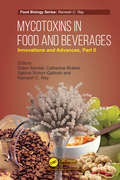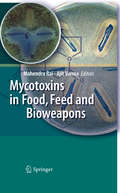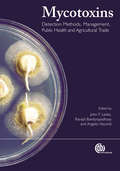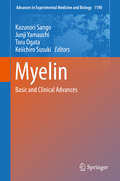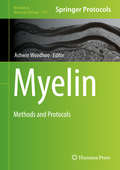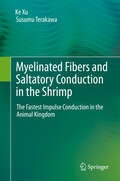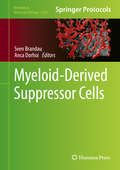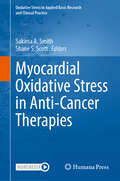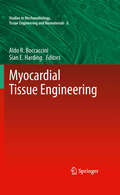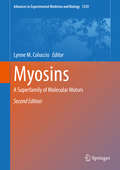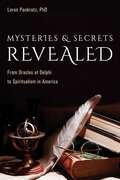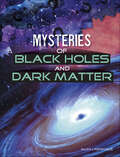- Table View
- List View
Mycotoxins in Food and Beverages: Innovations and Advances, Part II (Food Biology Series)
by Didier Montet; Catherine Brabet; Sabine Schorr-Galindo; Ramesh C. RayMycotoxins are secondary metabolites produced by fungi in a wide range of foods (cereals, peanut, tree nuts, dried fruits, coffee, cocoa, grapes, spices…) both in the field and after harvest, particularly during storage. They can also be found in processed foods of plant origin, or by transfer, in food products of animal (milk, eggs, meat and offal). Mycotoxins are of major concern since they can cause acute or chronic intoxications in both humans and animals which are sometimes fatal. Many countries, particularly in Europe, have set maximum acceptable levels for mycotoxins in food and feed. The book reviews the latest literature and innovations on important aspects of mycotoxins, e.g. mycotoxin producing fungi and the related ecosystems, mycotoxin occurrence, toxicity, analysis and management. Quantitative estimation of impacts of climate change on mycotoxin occurrence have been made recently, using predictive modelling. There is also a growing interest in studying the occurrence and toxicity of multiple mycotoxins in food and feed, including emerging or modified forms of mycotoxins. Innovative tools have also developed to detect and quantify toxinogenic fungi and their toxins. In order to reduce the use of chemicals that are harmful to the environment and health of consumers, alternative methods of prevention and decontamination of mycotoxins were tested in pre- and post-harvest, using microorganisms, natural substances or radiation treatments.
Mycotoxins in Food, Feed and Bioweapons
by Ajit Varma Mahendra RaiMycotoxins are made by different biosynthetic pathways, and they have an extremely wide range of pharmacological effects. This book will update readers on several cutting-edge aspects of mycotoxin research, including topics such as: new analytical methods for detection; the adoption of an ancient Mexican process for detoxification of aflatoxins; mycotoxin management in Ireland, Lithuania and South America; mycotoxin reduction through plant breeding and integrated management practices; and natural aflatoxin inhibitors from medicinal plants. Further contributions examine ochratoxins, selected trichothecenes, zearalenone, and aflatoxin-like gene clusters, as well as sclerotial development in Aspergillus flavus and A. parasiticus. Of particular interest are the chapters on the potential use of mycotoxins as bioweapons. This book will stimulate new thinking on the need to develop therapeutic as well as preventative interventions to reduce the toxicological threat of mycotoxins.
Mycotoxins: Detection Methods, Management, Public Health and Agricultural Trade
by J. Leslie Ramananda Bandyopadhyay A. ViscontiMycotoxins are produced worldwide by several fungi on a wide range of agricultural commodities and are closely related to human and animal food chains. Examining mycotoxins and their impact from a public health viewpoint, this book provides an overview and introduction to the subject and examines the health, trade and legislation issues involved. Management of mycotoxins is discussed in detail as well as the global problems caused by mycotoxins.
Myelin Repair and Neuroprotection in Multiple Sclerosis
by Ian D. Duncan Robin J FranklinMyelin Repair and Neuroprotection in Multiple Sclerosis presents an up-date on the translational potential of promoting remyelination in multiple sclerosis (MS). A number of research frontiers still exist in this challenging disease. The cause remains elusive, preventing breakthroughs in its prevention. The move towards oral immunomodulatory therapies has been a major advance, as has the finding of new genes linked to susceptibility that may open the door to new therapeutic approaches. However, a frontier that has been making significant strides in recent years has been that surrounding the neurobiology of myelin regeneration and axon protection: such have been the advances that clinical translation is on the cusp of being achieved. Two broad approaches to therapeutic enhancement of remyelination are envisaged: promoting endogenous remyelination by targeting cells present in the CNS, or, replacing lost myelinating cells from exogenous sources. Current research on oligodendrocyte biology, the pathology of MS, imaging of lesions and the biology of remyelination are paving the way toward opening this new translational frontier. Professor Duncan and Professor Franklin have assembled a broad group of experts in the fields of glial cell biology, neuropathology, radiology and clinical neurology to provide the background toward taking remyelination from experimented models into MS patients.
Myelin: Basic and Clinical Advances (Advances in Experimental Medicine and Biology #1190)
by Kazunori Sango Junji Yamauchi Toru Ogata Keiichiro SusukiThis book presents the latest exciting advances in understanding of the structure and function of myelin in the central and peripheral nervous systems under normal and pathological conditions. Readers will find state of the art information from the perspectives of both basic neuroscience and clinical neurology and neuropathology. Detailed attention is paid to the findings and implications of recent research on the myelin-forming glial cells such as oligodendrocytes and Schwann cells. The discussion of myelin pathology encompasses a wide range of diseases and conditions, including, for example, multiple sclerosis, Pelizaeus-Merzbacher disease, traumatic brain and spinal cord injuries, brain tumors of glial cell origin, Charcot-Marie-Tooth disease, immune-mediated neuropathy, and diabetic neuropathy. The authors comprise researchers at the cutting edge of biotechnology and experts in the diseases discussed. The clearly written text is supported by numerous high-quality light and electron microscopy, CT, and MR images.
Myelin: Biology and Chemistry
by Russell E. MartensonMyelin: Biology and Chemistry provides in-depth reviews and discussions regarding recent findings in the biology and chemistry of myelin. Topics are interdisciplinary and carry readers from the cellular level to that of the gene. Research in demyelinating diseases (naturally occurring and experimentally produced) is described and emphasizes autoimmune and virally induced mechanisms. Advances in molecular biology, such as those that provide details of the structures of the major myelin proteins, demonstrate the control of their synthesis, and explore the mutations within their genes that disrupt the process of myelination, are discussed in depth. Myelin: Biology and Chemistry will be an important addition to the libraries of molecular biologists, biochemists, cell biologists, physical chemists, immunologists, virologists, and pathologists involved in the study of myelin.
Myelin: Methods and Protocols (Methods in Molecular Biology #1791)
by Ashwin WoodhooThis volume collects research methodologies for both basic and translational studies of myelin authored by experts in the field. Chapters in this book are divided into three parts: Part One focuses on visualizing myelin and studying it on a biochemical level; Part Two looks at cell culture systems used to uncover key mechanisms that regulate formation and maintenance of myelin; and Part Three discusses modeling disorders of myelin in both CNS and PNS, and therapeutic strategies for targeting these disorders. Written in the highly successful Methods in Molecular Biology series format, chapters include introductions to their respective topics, lists of the necessary materials and reagents, step-by-step, readily reproducible laboratory protocols, and tips on troubleshooting and avoiding known pitfalls.Cutting-edge and comprehensive, Myelin: Methods and Protocols is a valuable resource for physiologists, molecular biologists, anatomists, cell and developmental biologists, and physician-scientists working in the field of myelin biology and the disorders associated with it.
Myelinated Fibers and Saltatory Conduction in the Shrimp
by Ke Xu Susumu TerakawaIn 1961, neurobiologists found that the conduction velocity of the nerve impulse in the giant nerve fiber of the Penaeus shrimp abdominal nerve cord was over 200 m/s, the highest speed of information transmission ever observed in the animal kingdom. The peculiar myelin sheath with its unique nodal structure and the electrical properties of the nerve fibers of the shrimp have continued to be investigated for a quarter of century and are now fully described in this book. The investigation dispels the commonly held belief that the fastest recorded impulse conduction is about 120 m/s in the thickest vertebrate myelinated nerve fibers. In the shrimp, researchers found a completely novel type of functional node in the giant fiber which they designated as the fenestration node. In portions of the myelinated fiber, the fenestration node furnished the sites of excitation. Also discovered was a new strategy for increasing impulse conduction in the shrimp. The book includes a section on the formation of the fenestration node and the discovery of a strategy that allows the shrimp to escape its predators by an action of the fastest velocity. The data presented in this volume on the myelin sheath of invertebrates present a new direction for this field and a rich source of information for neurobiologists worldwide.
Myeloid Cells in Health and Disease: A Synthesis (ASM Books)
by Siamon GordonThe structure, functions, and interactions of myeloid cells have long been the focus of research and therapeutics development. Yet, much more remains to be discovered about the complex web of relationships that makes up the immune systems of animals. Scientists today are applying genome-wide analyses, single-cell methods, gene editing, and modern imaging techniques to reveal new subclasses of differentiated myeloid cells, new receptors and cytokines, and important interactions among immune cells. In Myeloid Cells in Health and Disease: A Synthesis, Editor Siamon Gordon has assembled an international team of esteemed scientists to provide their perspectives of myeloid cells during innate and adaptive immunity. The book begins by presenting the foundational research of Paul Ehrlich, Elie Metchnikoff, and Donald Metcalf. The following chapters discuss evolution and the life cycles of myeloid cells; specific types of differentiated myeloid cells, including macrophage differentiation; and antigen processing and presentation. The rest of the book is organized by broad topics in immunology, including the recruitment of myeloid and other immune cells following microbial infection the role of myeloid cells in the inflammation process and the repair of damaged tissue the vast arsenal of myeloid cell secretory molecules, including metalloproteinases, tumor necrosis factor, histamine, and perforin receptors and downstream signaling pathways that are activated following ligand-receptor binding roles of myeloid cells during microbial and parasite infections contributions of myeloid cells in atherosclerosis myeloid-derived suppressor cells in tumor development and cancer Myeloid Cells in Health and Disease: A Synthesis will benefit graduate students and researchers in immunology, hematology, microbial pathogenesis, infectious disease, pathology, and pharmacology. Established scientists and physicians in these and related fields will enjoy the book's rich history of myeloid cell research and suggestions for future research directions and potential therapies.
Myeloid-Derived Suppressor Cells (Methods in Molecular Biology #2236)
by Sven Brandau Anca DorhoiThis volume explores various experimental approaches that can be used to investigate myeloid-derived suppressor cells (MDSC) and can be useful to understand the characterization of these cells. The chapters in this book cover topics such as the study of MDSC in human patient samples; employing flow cytometry or magnetic enrichment; immunophenotyping using multi-parameter flow cytometry and mass cytometry; functional characterization of MDSC by biochemical, immunological, and microscopy approaches; MDSC characterization through the use of high-resolution genomics; and novel methods of high-resolution visualization of living tissue and the purification of granulocytes. Written in the highly successful Methods in Molecular Biology series format, chapters include introductions to their respective topics, lists of the necessary materials and reagents, step-by-step, readily reproducible laboratory protocols, and tips on troubleshooting and avoiding known pitfalls.Cutting-edge and thorough, Myeloid-Derived Suppressor Cells: Methods and Protocols is a valuable resource for novices in this field to help them start their research on MDSC, and experienced investigators looking to establish new protocols in their lab. This book is great for anyone working in the field of biology, medicine, and veterinary medicine.
Myeloproliferative Neoplasms
by Ayalew Tefferi Srdan VerstovsekThis succinct resource provides an ideal balance of the biology and practical therapeutic strategies for classic and non-classic BCR-ABL-negative myeloproliferative neoplasms. Utilizing current World Health Organization nomenclature, classification, and diagnostic criteria, international experts have assembled to convey the most up-to-date knowledge in this rapidly evolving field. The opening chapters cover the diagnosis and classification, genetics, cytogenetic findings, and prognostic factors of MPNs. Further chapters explore therapies specific to the different disease entities, including polycythemia vera, essential thrombocytopenia, myelofibrosis, and eosinophilic disorders, and mastocytosis. Unique areas of discussion include JAK2 inhibitor therapy, hematopoietic stem cell transplantation, and blastic transformation. A valuable reference for practicing hematologists, this forefront book enriches our understanding of recent discoveries and their impact on conventional and investigational treatments.
Mykologie: Diversität, Morphologie, Ökologie und Evolution der Pilze
by Meike PiepenbringDieses Lehrbuch ist eine Einführung in die Mykologie und bietet einen Überblick über Pilze und Flechten in allen Teilen der Welt. Es umfasst Informationen zur aktuellen Systematik, zur Bedeutung der Pilze in Ökosystemen und für den Menschen, zur Morphologie, zu Entwicklungsgängen und zu chemischen Inhaltsstoffen. Zudem geht es um Mykorrhizen, Phytopathologie, medizinische Mykologie, Pilze in der Lebensmittelherstellung und vieles mehr. Das Buch enthält über 500 Fotos sowie 230 Grafiken zu Entwicklungsgängen, Merkmalen der verschiedenen Pilzgruppen, Stammbäumen und zellulären Strukturen. Dieses Buch richtet sich an alle, die in ihrem Studium, bei ihrer Arbeit oder in ihrer Freizeit mit Pilzen zu tun haben. Es dient als Lehrbuch, als Nachschlagewerk oder zum Schmökern auf der Entdeckung schöner Farben, überraschender Formen und kurioser Eigenschaften von Pilzen und Flechten. Gute Erklärungen und reiche Bebilderung helfen beim Verständnis auch komplexer Zusammenhänge.
Myocardial Oxidative Stress in Anti-Cancer Therapies (Oxidative Stress in Applied Basic Research and Clinical Practice)
by Sakima A. Smith Shane S. ScottThis book summarizes the present knowledge of oxidative stress in anti-cancer drug-induced cardiotoxicity and covers cell molecular mechanisms, prevention and treatment strategies, drug research, and population experiments. Racial and gender disparities in anticancer therapy-related cardiotoxicity are also covered. Book chapters provide current and timely review of hypothesis-driven research, case studies, and review articles. As such, this book serves as a source of knowledge and guidance for research, clinical prevention, and treatment of cardiotoxic anticancer drugs. Furthermore, this book is essential for students, cardiologists, cardio-oncologists, and heart failure researchers.
Myocardial Tissue Engineering
by Aldo R. Boccaccini Sian HardingMyocardial tissue engineering (MTE), a concept that intends to prolong patients' life after cardiac damage by supporting or restoring heart function, is continuously improving. Common MTE strategies include an engineered 'vehicle', which may be a porous scaffold or a dense substrate or patch, made of either natural or synthetic polymeric materials. The function of the substrate is to aid transportation of cells into the diseased region of the heart and support their integration. This book, which contains chapters written by leading experts in MTE, gives a complete analysis of the area and presents the latest advances in the field. The chapters cover all relevant aspects of MTE strategies, including cell sources, specific TE techniques and biomaterials used. Many different cell types have been suggested for cell therapy in the framework of MTE, including autologous bone marrow-derived or cardiac progenitors, as well as embryonic or induced pluripotent stem cells, each having their particular advantages and disadvantages. The book covers a complete range of biomaterials, examining different aspects of their application in MTE, such as biocompatibility with cardiac cells, mechanical capability and compatibility with the mechanical properties of the native myocardium as well as degradation behaviour in vivo and in vitro. Although a great deal of research is being carried out in the field, this book also addresses many questions that still remain unanswered and highlights those areas in which further research efforts are required. The book will also give an insight into clinical trials and possible novel cell sources for cell therapy in MTE.
Myofibroblasts: Methods and Protocols (Methods in Molecular Biology #2299)
by Boris Hinz David LagaresThis detailed book explores the fundamentals of myofibroblast biology in tissue repair, fibrosis, and tumors as well as providing cutting-edge laboratory methods used to investigate myofibroblast functions in physiological and pathological settings in vitro and in vivo, as written by leading academic scientists. Section I of this volume focuses on fundamental methods to study myofibroblast biology and covers topics such as methods for detecting myofibroblasts and senescent myofibroblasts in cell culture and histology, single cell RNA sequencing to identify myofibroblast subsets in fibrotic tissues, and functional assays to assess TGF-β activation, myofibroblast apoptosis, or matrix deposition and crosslinking. Section II discusses methods to investigate the mechanobiology of myofibroblasts in vitro, including the fabrication of functional hydrogels with tunable stiffness, the use of atomic force microscopy to characterize matrix and cellular stiffness, as well as molecular assays to assess fibroblast mechanotransduction pathways and durotaxis. Section III describes multiple animal models to investigate myofibroblast functions across organs in vivo as well as human organoid systems, precision tissue slices and decellularized 3D tissue scaffolds to assess myofibroblast functions in relevant human ex vivo models. Written for the highly successful Methods in Molecular Biology series, chapters include introductions to their respective topics, lists of the necessary materials and reagents, step-by-step, readily reproducible laboratory protocols, and tips on troubleshooting and avoiding known pitfalls. Authoritative and extensive, Myofibroblasts: Methods and Protocols is an essential collection for researchers delving into the processes and effects of these important cells.
Myogenesis
by Joseph X. DimarioOur understanding of the molecular and cellular mechanisms that control skeletal muscle development, regeneration, and adaptive responses to activity has increased dramatically in recent years, fostered by innovative techniques and approaches that are either specifically designed or adapted for research in skeletal muscle biology. Myogenesis: Methods and Protocols presents detailed, step-by-step methods in the study of the molecular and cellular biology of skeletal muscle cells. Protocols from different model systems including mammalian, avian, zebrafish, and invertebrate skeletal muscle are included in this volume. Highlighted topics cover a wide range of interests and expertise including myogenic and stem cell isolation, investigation of models of exercise and disuse, viral vector delivery systems, calcium imaging, cell profiling, as well as protein-DNA and protein-protein interactions. Written in the highly successful Methods in Molecular BiologyTM series format, chapters include introductions to their respective topics, lists of the necessary materials and reagents, readily reproducible laboratory protocols, and tips on troubleshooting and avoiding known pitfalls. Comprehensive and authoritative, Myogenesis: Methods and Protocols serves as an invaluable, state-of-the-art resource for experienced and emerging scientists in basic research as well as clinical and regenerative medicine.
Myogenesis
by Sissel Beate RønningThis detailed volume collects many of the common experimental approaches used to study myogenesis. It covers subjects ranging from isolation and purification protocols, manipulation of muscle cells, transcriptomics and proteomics, metabolism and exercise, and tissue engineering. Presented methods involve different species, including human, bovine, Atlantic salmon, rats, mice, larval zebrafish, and Drosophila melanogaster. Written for the highly successful Methods in Molecular Biology series, chapters include introductions to their respective topics, lists of the necessary materials and reagents, step-by-step, readily reproducible laboratory protocols, and tips on troubleshooting and avoiding known pitfalls. Authoritative and practical, Myogenesis: Methods and Protocols aims to serve as an essential part of many laboratory libraries and to assist researchers throughout the world in revealing the unknowns of myogenesis.
Myosins: A Superfamily of Molecular Motors (Advances in Experimental Medicine and Biology #1239)
by Lynne M. ColuccioThis highly authoritative volume highlights the remarkable superfamily of molecular motors called myosins, which are involved in such diverse cellular functions as muscle contraction, intracellular transport, cell migration and cell division. In a timely compilation of chapters written by leading research groups that have made key discoveries in the field, the current understanding of the molecular mechanisms and biological functions of these intriguing proteins is explored.
Myself and Other Animals: A posthumous work from the beloved conservationist to celebrate the centenary of his birth
by Gerald DurrellA posthumous work from the beloved conservationist and naturalist Gerald Durrell, to celebrate the centenary of his birth, with a new foreword by HRH Princess Anne.‘Gerald Durrell was magic’ SIR DAVID ATTENBOROUGH ‘A wise, genial and world-encompassing book’ SUNDAY TIMES ‘Fills important gaps in the biographical narrative . . . Truly, there is magic here’ GUARDIAN Myself and Other Animals is a new book mosaicked from unpublished autobiographies, uncollected pieces and previously published extracts from Durrell’s work and archives. The result is an extraordinary journey through Durrell’s life in his own words, edited and introduced by his widow Lee Durrell.Drawing on a memoir that Durrell started writing before he became too ill to continue it, and an unfinished book from a trip to Australia in 1969 to the Great Barrier Reef, Northern Territory and Queensland, here is the unvarnished story of Durrell’s life, from touching family tributes to golden bats and pink pigeons.Moving from India to England and then to the always sun-lit Corfu, told with dry wit and insight into our fellow animals, here is the vivid finale of one of Britain’s most beloved conservationists and prose stylists.'Funny and readable and hugely charming' i ‘One of the finest and most lyrical nature writers in English’ OBSERVER'A moving tribute to Gerald's endeavours and achievements as a conservationist' SPECTATOR
Mysteries and Secrets Revealed: From Oracles at Delphi to Spiritualism in America
by Loren Pankratz Ph.DMysteries and Secrets Revealed uncovers the reality behind mysteries of nature and secrets of frauds that eluded common understanding. The journey begins in the ancient Greek city of Delphi, where priests claimed the gift of a priceless gold lion was an acknowledgement of their clairvoyant powers. But their concocted story concealed an embarrassing blunder. Those sufficiently savvy to catch the lie became aware of even deeper problems. Author Loren Pankratz then guides us through the conflicts of Renaissance scholars, including Galileo who explained things in ways that enraged philosophers and infuriated priests. Galileo's methods of investigation were perpetuated by the meticulous work of the Academy of Experiment, and Bernard Fontenelle's enthralling dialogue enabled common people to accept life in the rearranged sun-centered universe. Clairvoyants in a mesmeric trance claimed they could visit distant planets and endure brutal surgical procedures. If any of this was real, how was it possible? One nineteenth century mesmeric savant, Alexis Didier, was so convincing that someone claimed no case of clairvoyance could be made for anyone if his accomplishments were not real. This unchallenged declaration is now unraveled here for the first time through information gleaned from uncommon documents and rare antiquarian pamphlets. The surprising manifestations of modern spiritualism quickly escalated into a psychic arms race that included mysterious tipping and turning of tables. Scientist Michael Faraday devised ingenious experiments to show how subtle muscle reactions outside of awareness created these manifestations. On the other hand, explanations for table levitations and mysterious writing on slates could only be solved by individuals with acute observational skills and acquainted with the methods of trickery.Each story in Mysteries and SecretsRevealed captures the tension of conflict, the thrill of discovery, and the strategies of science that unmasked frauds, fakes, false belief, and the enigmas of our natural world.
Mysteries and Secrets of Time
by Lionel And FanthorpeThis fascinating work begins with a scientific appraisal of time and its relationship with 3D space. It explains in clear, understandable language, the complex theories of such famous men as Newton, Einstein, and Stephen Hawking. Is time infinite, or does it have a beginning and an end? Do Black Holes and White Vortices distort time, or penetrate it? The authors also analyse and evaluate puzzling, well documented reports of time travel and reincarnation, and strange cases of deja vu. Can time travel account for such anachronistic discoveries as a 20th century sparkplug found encased among fossils half a million years old? Finally, the authors bring all the unsolved time-related mysteries together in a unified field theory that suggests an awesome answer to the mysteries of time-travel and reincarnation.
Mysteries of Black Holes and Dark Matter
by Ellen LabrecqueWhat is a black hole? What is dark matter and what is it made of? How do scientists discover black holes and dark matter if they can’t be seen? What do scientists know about these mysterious parts of the universe and what do they still hope to find out? Budding astronomers will learn the answers to these questions and more!
Mysteries of Black Holes and Dark Matter
by Ellen LabrecqueWhat is a black hole? What is dark matter and what is it made of? How do scientists discover black holes and dark matter if they can’t be seen? What do scientists know about these mysterious parts of the universe and what do they still hope to find out? Budding astronomers will learn the answers to these questions and more!
Mysteries of Black Holes and Dark Matter (Solving Space's Mysteries)
by Ellen LabrecqueWhat is a black hole? What is dark matter and what is it made of? How do scientists discover black holes and dark matter if they can’t be seen? What do scientists know about these mysterious parts of the universe and what do they still hope to find out? Budding astronomers will learn the answers to these questions and more!
Mysteries of Mars (Springer Praxis Books)
by Fabio Vittorio De BlasioThis book introduces the reader to the wonders of Mars, covering all aspects from our past perceptions of the planet through to the latest knowledge on its history, its surface processes such as impact cratering, volcano formation, and glaciation, and its atmosphere and climate. In addition, a series of ten intriguing open issues are considered in a more advanced way. These include such thought-provoking questions as What turned off the planet’s magnetic field?, Why are the northern and southern hemispheres so different?, What was the fate of the once abundant water?, and Is there, or was there, life on Mars? Numerous original figures, unavailable elsewhere, reproduce details of images from Viking, CTX, MOC, HiRISE, THEMIS, and HRSC. The book will appeal especially to general readers interested in planetary sciences, astronomy, astrogeology, and space exploration and to students of Earth Sciences and Natural and Environmental Sciences. The higher-level material on the remaining mysteries of Mars will also be of interest to astrogeologists and other researchers.
